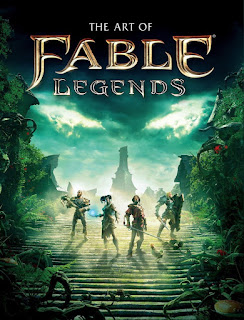Reviewing books, films, video games and all things science fiction.
Saturday, 12 March 2016
The Art Of Fable Legends by Martin Robinson (Book Review)
Art books like this are supposed to help shed light on a creation of a work. In examples like Pacific Rim, Fallout 4 or Bioware's various works, they're supposed to show the inner workings of just how something comes to be. Whether it's talking personally about the creative thought behind a character or environment, or even how they play upon certain traditional tropes with their ensemble of heroes, it's always worth it to truly see just what goes into any AAA production. While The Art of Fable Legends accomplishes that, it's also something far more than any other work. With the cancellation of the game and Lionhead Studios shutting down, it's one final look at the world of Albion and a glimpse of the fantastical world now lost to us.
As you might imagine, there's no story here in the slightest. There's no real joining narrative and the closest you really get to anything is the thought process behind each character. The same can somewhat be said with the locations the book covers, citing the initial concepts behind them, but beyond that the real meat of the work is the design process. You see sketch after sketch of each environment, character and item, showing how they were gradually shaped into a final definitive piece. This is a surprisingly easy thing to get wrong in most cases, and many books do commit more than a few creative sins. Sometimes such imagery is reduced to simple padding, producing grey, unfinished renders for pages on end without any substance or commentary. In some cases the commentary itself can be either cast aside entirely, or it can become little more than a sales pitch for the game, revealing nothing of the people working on it, or the thoughts behind it. Here though, there's a near perfect balance struck. Each character is limited to a few set pages, each divided among what stage of creation they are at an a paragraph defining their inspiration. Through this, you're truly given an idea of what their personality would have been, their class and role within the story, and many become far more lifelike as a result.
Oddly enough the creative thought and overall process is most evident with the enemies more than anything else. This seems to be the point where the designers could truly delve into the Paul Kidby inspired elements of the Fable world, where the true zaniness seemed to seep through. While many tended to be mere fodder for the heroes, they nevertheless had unique or more individual features which helped them stand out. Whether this was the nails tacking a foe's hat into place or the glowing lantern suspended within a suit of seemingly animated armour, these small touches help to give them oddly human traits. It's just a level of detail which seems to be so often forgotten in so many modern creations, especially when it comes to the mooks. This isn't to bash anyone in particular but, to cite two examples, Mass Effect never pushed to give its foes much in the way of individually distinct traits and you'd be hard pressed to tell one Halo Grunt from the next. Both were great franchises to be sure, but this stylistic level of thought always helped give Lionhead an edge over their competition. In the art department of course, gameplay or storytelling was often another matter, especially in its later years.
If there is a truly weak part to be found here, it's that the book never pushes quite so far as the best of its kind. Pacific Rim went into things blow by blow, showing much of the world the film never could and a great deal of the production structure itself. When the book paused to talk about each individual team, or how certain sets were created, there was a real sense of insight and personal touch to the various descriptions. Plus, atop of all of this, the actual inspirations and ideas the film paid tribute to were cited time and again, until you were truly certain of just how massive some of the science fiction/kaiju/horror fans on the film were. Fable sadly tends to draw the line at the ideas or just the works themselves. You don't get much in the way of real behind the scenes thoughts or the company in question, which can make it seem as if the book is holding back certain bits of info.
Still, not going far enough with some text pieces is a minor quibble at best, and there's no denying this is a fantastic book. Even fantasy fanatics who usually avoid Fable would do well to give this one a look. It's a beautiful creation and even just as an isolated work it truly remains a dynamic and stunning guide to a unique ghouls, swords and dungeons setting. If this hasn't put that across to you, seriously take a few minutes to make a few Google searches and eye up the contents for yourself. Trust me, you won't regret it.
Subscribe to:
Post Comments (Atom)

I wouldn't have known about this without this article, and I have to say, this artbook is the kind I love, it's not just the boring 20 pages of concept art that Ubisoft puts out for their AC game, it goes really in depth and was a great read.
ReplyDeleteHonestly, that's exactly why I opted to cover this one. It's usually difficult to cover artbooks of any kind unless they go into this kind of substantial information or level of detail, but here there's real insight into the process behind things. I just really wish there were more like this one in the world.
Delete